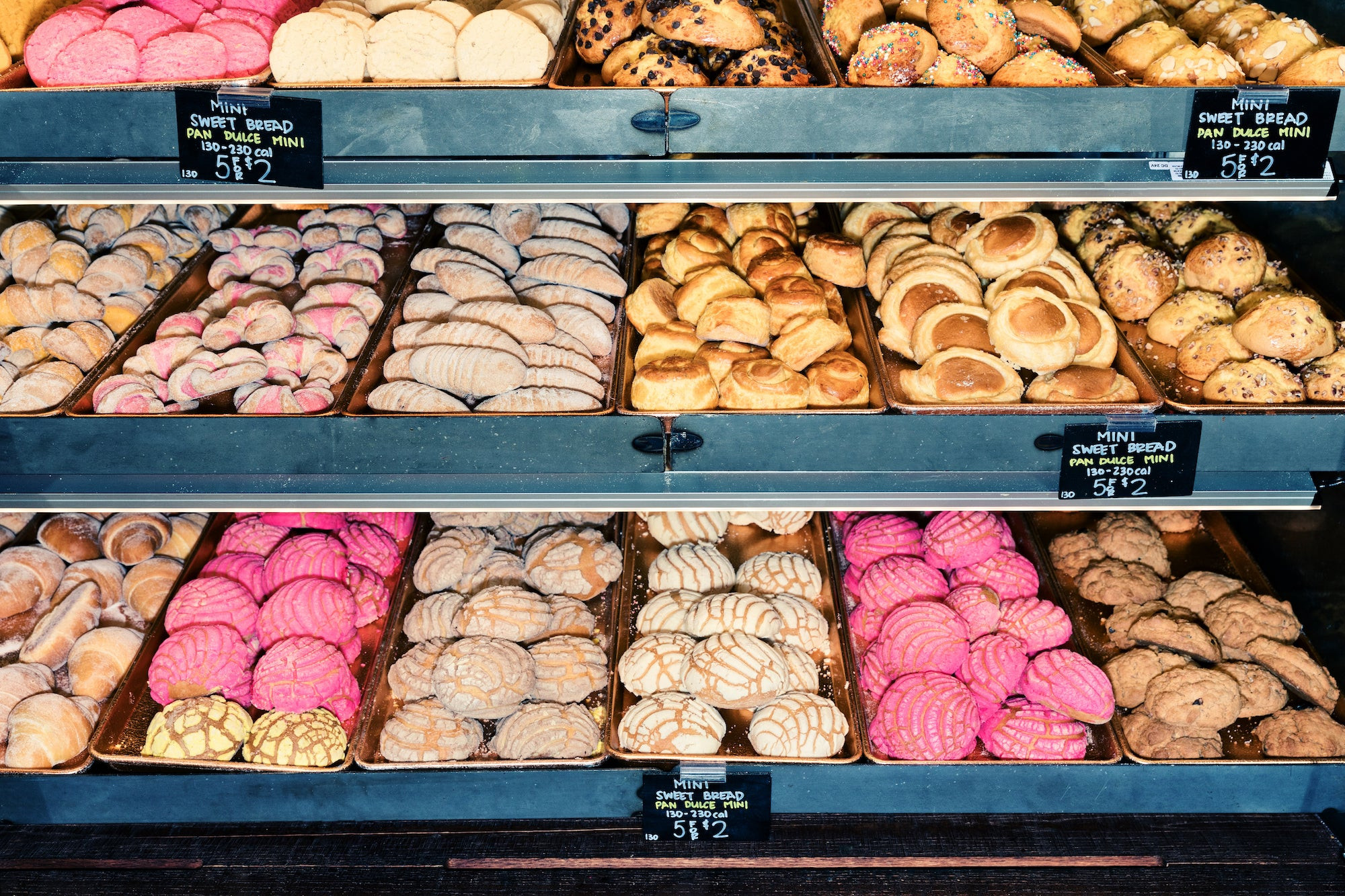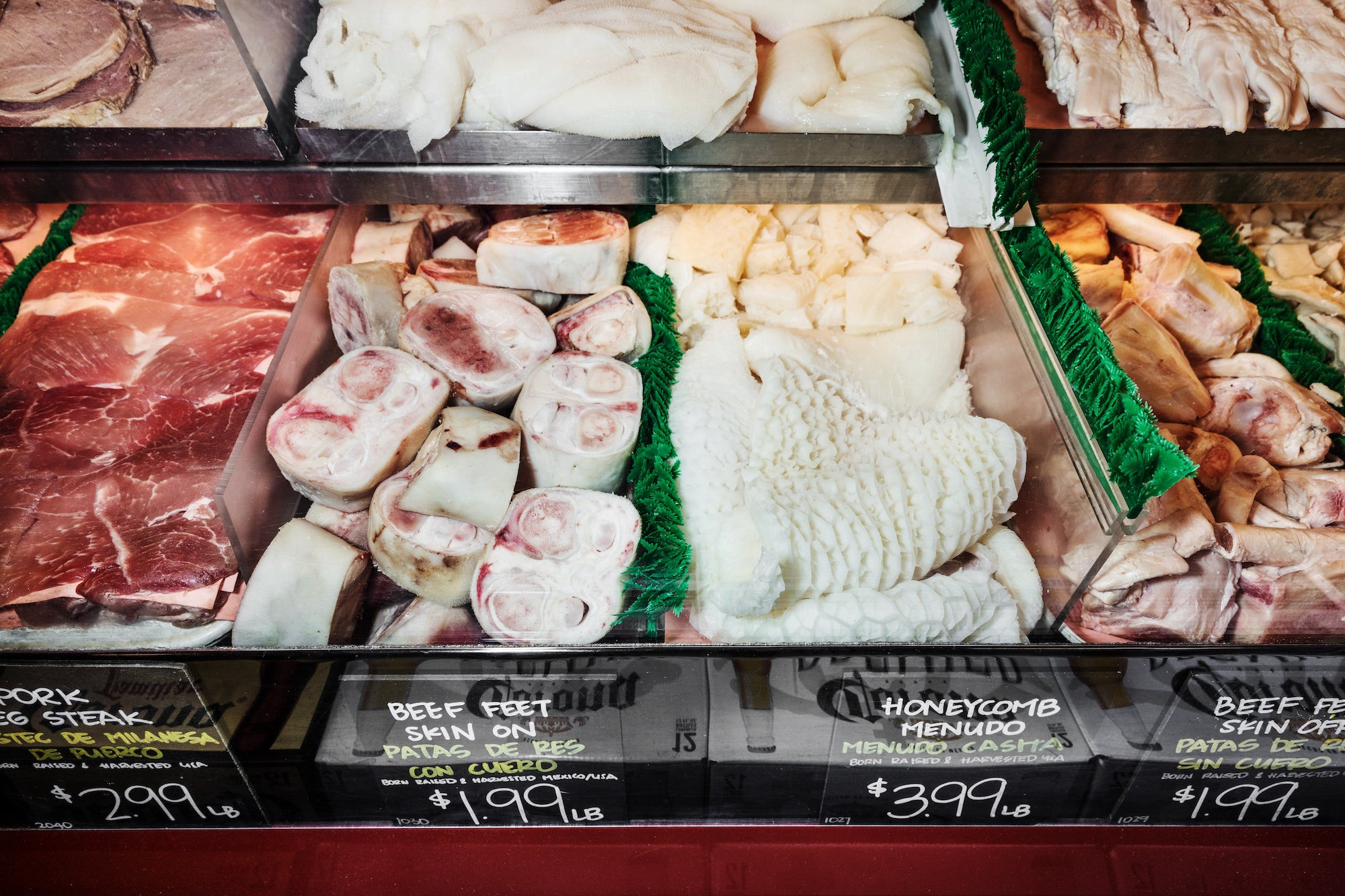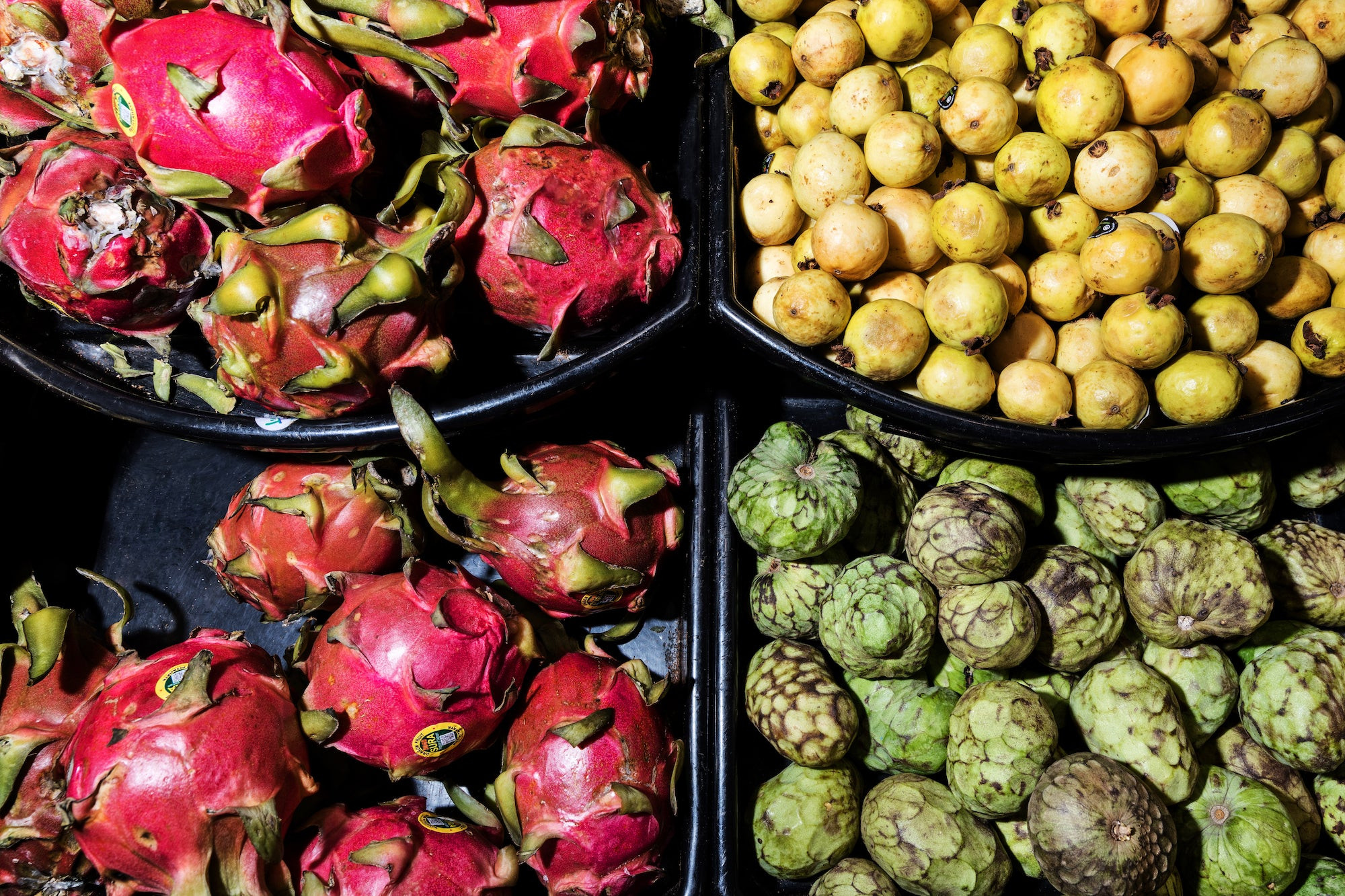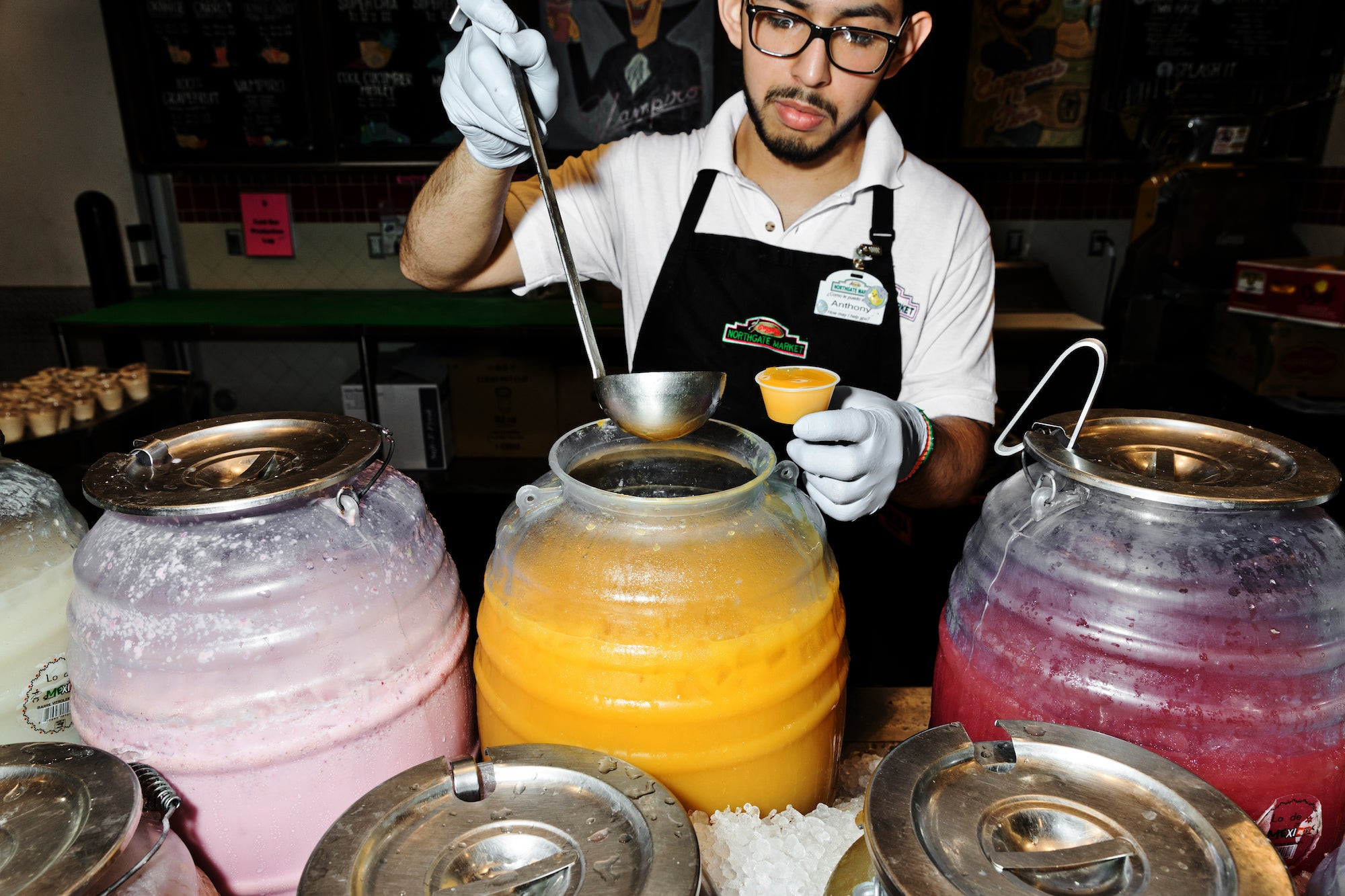For many, especially those raised in immigrant households, Mexican Grocery Stores are more than just places to buy food; they are cornerstones of community and culture. Growing up in a family with limited income, I experienced firsthand the invaluable role these markets played. Our local Northgate González market in Pico Rivera, Los Angeles, was a lifeline. With just a couple of dollars, we could secure staples like bolillos and avocados – the makings of budget-friendly avocado toast long before it became trendy. Add in some flavorful Mexican chorizo, eggs, and potatoes, and our family was well-fed for under $10. Thanks to the affordability and variety of Mexican grocery stores, food scarcity was not part of my childhood experience, even when financial resources were tight.
 Aisles of fresh produce and grocery items inside a Northgate Gonzalez mexican grocery store, a popular destination for authentic ingredients and affordable prices.
Aisles of fresh produce and grocery items inside a Northgate Gonzalez mexican grocery store, a popular destination for authentic ingredients and affordable prices.
Today, Mexican-owned markets are ubiquitous throughout California, so much so that their significance can be easily overlooked. Stepping into one, you’re immediately greeted by the aroma of freshly baked tortillas, vibrant displays of jicama, and carnicerías brimming with choices from whole mojarra to meticulously prepared tripe – all at prices that are accessible. However, this wasn’t always the case. There was a time when these markets were scarce, and their explosive growth in the 1990s became a crucial support system for the massive wave of immigrants arriving in the United States.
The 1990s witnessed a dramatic surge in Mexican immigration to the U.S., both documented and undocumented, reaching its peak towards the decade’s end. For newly arrived families like Layidua Salazar’s, a well-stocked Mexican market was so fundamental that she divides her American childhood into two eras: “before the market and after the market.”
“Back then, you couldn’t even find basic tortillas in mainstream chain grocery stores.”
“Before we started shopping at a Mexican market, getting specific ingredients meant relying on family visits from Mexico,” Salazar explains. “We’d have a list of desired items for them to bring. But once we found the market, everything changed. Suddenly, we had access to all the familiar ingredients we longed for.”
 Layidua Salazar recalling her experiences with Mexican grocery stores and their impact on her community and access to authentic Mexican ingredients.
Layidua Salazar recalling her experiences with Mexican grocery stores and their impact on her community and access to authentic Mexican ingredients.
Salazar’s family immigrated to Oakland, California, from Guadalajara, Mexico, in 1991. While Oakland’s Fruitvale neighborhood was developing a Mexican community, it primarily consisted of people from Northern Mexico. Salazar, originating from Guadalajara, felt a sense of displacement.
“You have to understand that at chain grocery stores at the time, you couldn’t even find tortillas,” Salazar emphasizes. “Growing up in suburban Guadalajara, walking to the tortilleria for fresh tortillas was a daily routine. Coming to the U.S. felt like a huge loss of community and familiar comforts.”
“During the 90s, concerns about workplace raids, even in regular American grocery stores, were widespread. Shopping at a Mexican market, surrounded by community, provided a sense of security.”
Then, her family discovered Hernandez Meat Market. Rafael Hernandez, a Mexican immigrant who arrived in the U.S. in the late 1970s, established the carnicería in 1986. At that time, it was one of only three carnicerías in Fruitvale, which is now a predominantly Latino area saturated with Mexican markets.
 Rafael Hernandez standing proudly in his carniceria, Hernandez Meat Market, showcasing a variety of meat cuts and products available to his community.
Rafael Hernandez standing proudly in his carniceria, Hernandez Meat Market, showcasing a variety of meat cuts and products available to his community.
“Walking into Hernandez Meat Market felt distinctly different from an American grocery store, and not just because the food reminded me of home,” Salazar recalls. “In the 90s, rumors and news of workplace raids, sometimes even at mainstream American grocery stores, were circulating. Shopping at a place where you were surrounded by your community felt inherently safer and more welcoming.”
Today, “ethnic aisles” in mainstream grocery stores – offering items like mole jars and dried chiles – and “Latino markets,” known for their abundant and affordable produce sections, are relatively common across the nation. Carnicerías are even found in rural Southern towns. However, in the 1990s, a place like Hernandez Meat Market was a rare and vital resource. These markets provided newly arrived Mexican immigrants not only with essential ingredients for dishes like mole, birria, and pambazos but also with a much-needed sense of community, belonging, and immigrant-friendly services. These services included bilingual assistance, wire transfers, prepaid calling cards, and check cashing, often without the predatory interest rates prevalent in American chains targeting low-income communities of color.
The boom in Mexican-owned markets during the 1990s directly coincided with the increase in Mexican migration to California. Southern California, due to its proximity to the border, was the epicenter of this trend in the 1980s. As Gustavo Arellano reported for L.A. Taco, this era saw the emergence of now-dominant chains like Northgate González, which spearheaded “a wave of Latino supermarket chains that spread across Southern California during the 1980s, almost all founded by immigrants from Jalisco.” Vallarta Market, another major chain, followed a similar trajectory, expanding throughout Southern California in the 1990s to serve the growing Mexican population.
 A vibrant display of fresh produce at Northgate Gonzalez Markets, highlighting the wide variety and quality available at Mexican grocery stores.
A vibrant display of fresh produce at Northgate Gonzalez Markets, highlighting the wide variety and quality available at Mexican grocery stores.
While the surge in Mexican migration to the U.S. in the 1990s is often linked to U.S. economic growth and job opportunities, the reality is more complex. The North American Free Trade Agreement (NAFTA), signed in 1993, played a significant, often overlooked, role. Intended to facilitate trade between the U.S., Canada, and Mexico, NAFTA, upon implementation in 1994, had devastating consequences for the Mexican economy. These included wage decline, increased unemployment, and the displacement of approximately 2 million farmers. Mexican farmers were forced to compete, without subsidies, against heavily subsidized U.S. producers, particularly in corn production. The pork industry in Mexico also suffered severely due to U.S. imports.
Even before NAFTA, anti-Mexican immigration sentiment existed in the U.S., and it intensified after the agreement. California became a focal point of this sentiment. In 1994, the state passed Proposition 187, an anti-immigrant law aimed at denying undocumented children access to public education and initiating deportation proceedings for families without authorization. Ironically, then-Mexican President Carlos Salinas de Gortari toured the U.S., arguing that NAFTA would reduce migration by creating jobs in Mexico. Instead, it became a significant driver of Mexican migration to the U.S.
 A customer selecting produce in a Mexican grocery store, showcasing the everyday shopping experience and the importance of fresh ingredients in Mexican cuisine.
A customer selecting produce in a Mexican grocery store, showcasing the everyday shopping experience and the importance of fresh ingredients in Mexican cuisine.
Beto Chavez’s family story isn’t directly tied to NAFTA-driven migration, but he acknowledges its impact on some of his customers. Chavez is the general manager of Chavez Supermarkets and the son of founder David Chavez.
In 1984, David Chavez, who immigrated to the U.S. in the 1970s, opened Chavez Meat Market in Redwood City, in the San Francisco Bay Area. The carnicería and taqueria formed the business’s core. As the business expanded, it evolved into Chavez Supermarkets, opening a second store in 1993 and growing to four locations by 2001. Today, Chavez Supermarkets has ten locations across the Bay Area.
 Beto Chavez, General Manager of Chavez Supermarkets, standing in one of his family's stores, representing the second generation of a successful Mexican grocery business.
Beto Chavez, General Manager of Chavez Supermarkets, standing in one of his family's stores, representing the second generation of a successful Mexican grocery business.
Chavez notes that the growth of his family’s supermarkets mirrors the expansion of the Bay Area’s Mexican community.
“My father strategically followed customer patterns in the Bay Area, but our expansion and store locations were also influenced by our own family’s experiences,” Chavez recalls.
In essence, Chavez’s father aimed to provide his community with what he had lacked upon his arrival in the Bay Area. The Chavez family vividly remembers the frustration of tamale season arriving with no masa available for purchase. While Maseca, a popular instant masa brand, is now widely accessible even at Walmart, this wasn’t always the case.
“For Layidua Salazar, Hernandez Meat Market served as a vital link to Mexico, a country she cannot return to as an undocumented immigrant.”
“Initially, immigration from Mexico was a significant factor in our success. However, today we cater to second and third-generation customers as well,” Chavez explains. “Mexican ingredients are more widely available now, but the experience isn’t quite the same. Mainstream stores often lack the authenticity of Mexican markets. People consistently seek the traditional, authentic items they grew up with. They know we will have familiar favorites like galletas María, Jarritos soda, and the specific meat cuts they expect. This familiarity provides comfort and a sense of nostalgia.”
 Shelves stocked with authentic Mexican products like Jarritos soda and Galletas Maria cookies in a Mexican grocery store, appealing to customers seeking familiar brands from home.
Shelves stocked with authentic Mexican products like Jarritos soda and Galletas Maria cookies in a Mexican grocery store, appealing to customers seeking familiar brands from home.
For Salazar, Hernandez Meat Market became a crucial link to Mexico, a country she cannot return to as an undocumented immigrant. Food became, and remains, a vital cultural connection to her homeland. In American culture, introducing a significant other to family often involves images of a father carving a holiday turkey or ham. Salazar’s family tradition was different: her father slicing cow tongue from Hernandez Meat Market “on a random Tuesday.”
“While I assimilated into American culture, our home remained distinctly Mexican, and food was central to that identity,” Salazar says. “Hernandez Market was incredibly important for preserving and passing down our traditions and culture. As a child, watching my mom make salsa might have seemed mundane, but as an adult, I understand it’s so much more than just cooking.”
 A family shopping together in the meat section of a Mexican grocery store, highlighting the market as a place for family and community interaction.
A family shopping together in the meat section of a Mexican grocery store, highlighting the market as a place for family and community interaction.
Hernandez initially viewed his carnicería as a business, a way to utilize his meat-cutting skills acquired while working in a Mission District market after immigrating to the U.S. However, once opened, he quickly recognized the deep connection between his business’s success and the immigrant community. He witnessed firsthand the profound impact his market had on newly arrived Mexican families like Salazar’s.
“All of us market owners, not just myself, strive to give our customers the joy of experiencing the flavors and traditions that make them feel at home, surrounded by their people,” Hernandez says, referring to their in-house marinated and seasoned meats. “I believe our customers feel at home when they step into our market. That is deeply important to me, and I am committed to helping and serving my community in any way I can.”
Sometimes, the comforting details were subtle. The sight of a whole pig head in the carnicería, something unimaginable in a Safeway, brought Salazar a sense of familiarity and delight. Similarly, the absence of American staples like Hershey’s chocolate, replaced by Paleta Payaso or Bubu Lubu, reinforced the feeling of home.
 Mexican candies and snacks like Bubu Lubu and Paleta Payaso displayed in a Mexican grocery store, offering familiar treats and a taste of home.
Mexican candies and snacks like Bubu Lubu and Paleta Payaso displayed in a Mexican grocery store, offering familiar treats and a taste of home.
Mexican-owned markets are now evolving to serve the needs of another growing immigrant population: Central Americans. Chavez’s stores, for instance, now offer Salvadoran staples like pupusas, loroco, and frijol rojo de seda, alongside Goya products, a brand specializing in Latin American items from countries beyond Mexico, including Colombia and Venezuela.
Salazar finds comfort in this evolution, recognizing food as a fundamental aspect of Latinx culture and community. “Having access to your traditional foods is essential,” she states, emphasizing her desire for other immigrant communities to have the same access.
“Imagine constantly longing for home but being unable to return. That’s the reality for many of us who are undocumented,” Salazar reflects. “Being able to experience even a small taste of home can make a huge difference. During challenging times in my immigration process, I find myself gravitating to my parents’ house more often to share meals. It’s become incredibly clear to me that food is a powerful way to feel and stay connected.”
Photographs taken at Northgate González Markets in Anaheim, California
